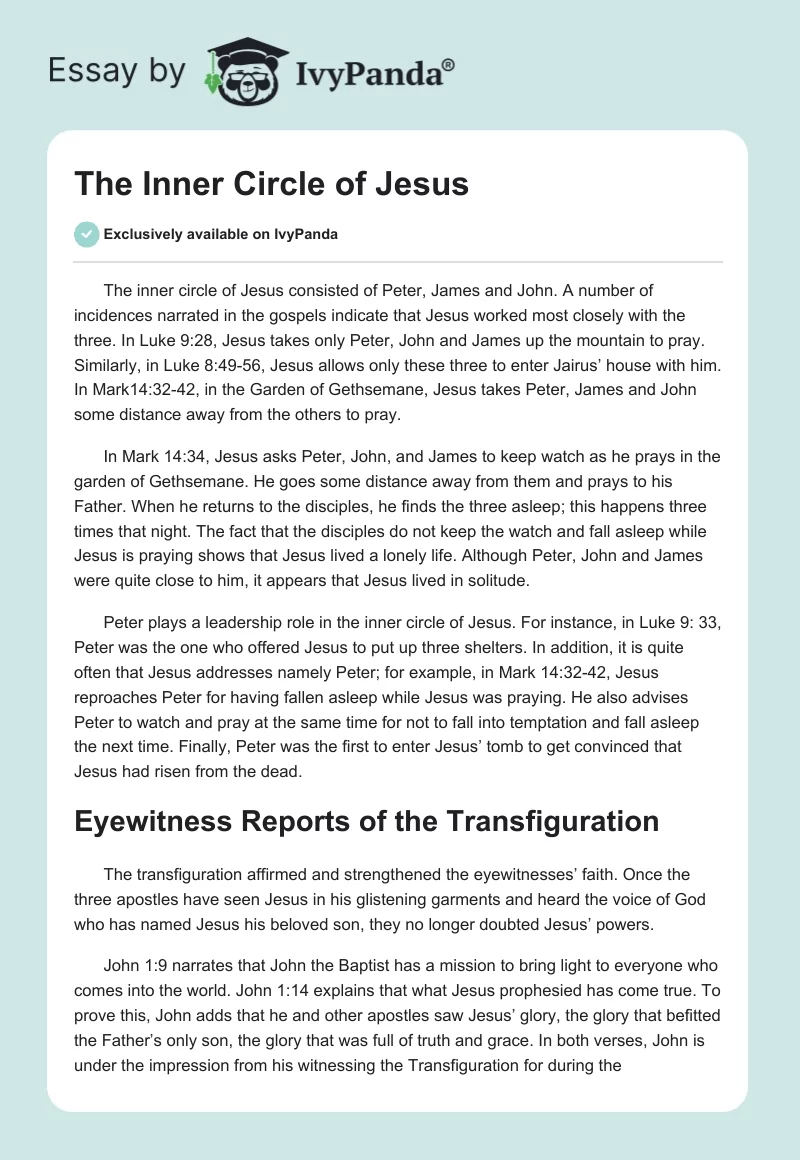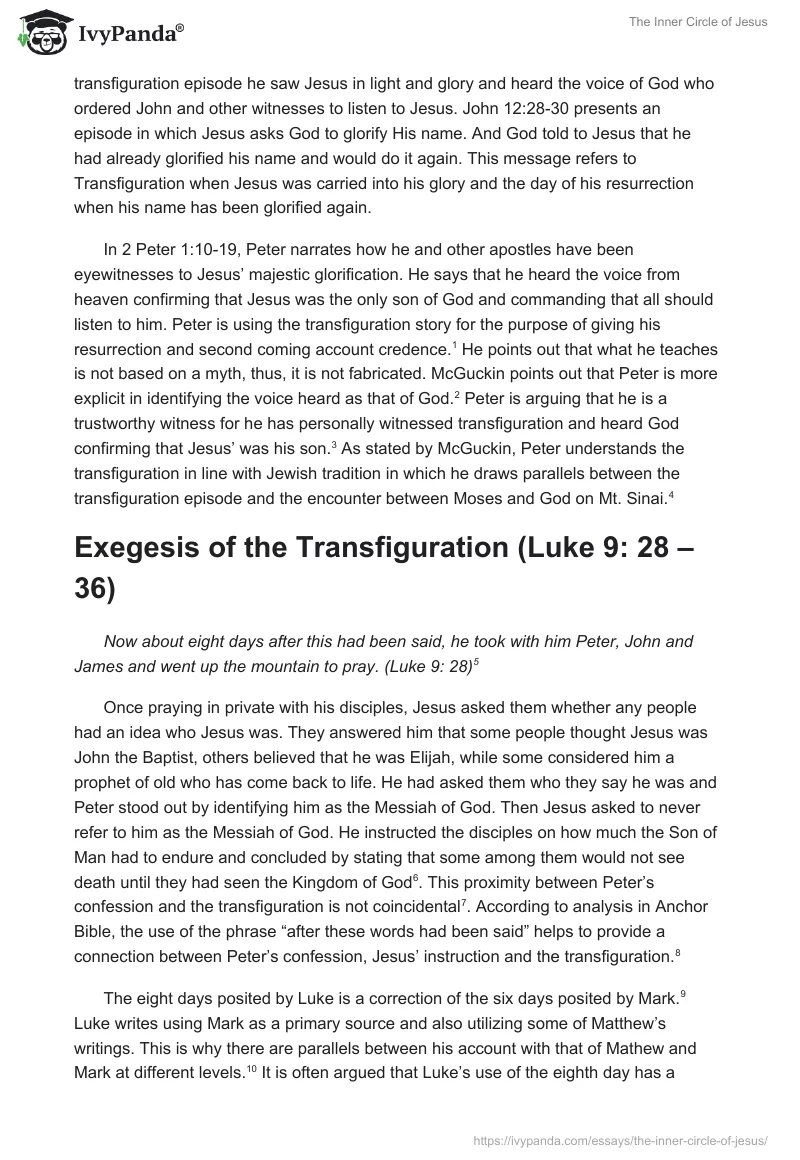The inner circle of Jesus consisted of Peter, James and John. A number of incidences narrated in the gospels indicate that Jesus worked most closely with the three. In Luke 9:28, Jesus takes only Peter, John and James up the mountain to pray. Similarly, in Luke 8:49-56, Jesus allows only these three to enter Jairus’ house with him. In Mark 14:32-42, in the Garden of Gethsemane, Jesus takes Peter, James and John some distance away from the others to pray.
In Mark 14:34, Jesus asks Peter, John, and James to keep watch as he prays in the garden of Gethsemane. He goes some distance away from them and prays to his Father. When he returns to the disciples, he finds the three asleep; this happens three times that night. The fact that the disciples do not keep the watch and fall asleep while Jesus is praying shows that Jesus lived a lonely life. Although Peter, John and James were quite close to him, it appears that Jesus lived in solitude.
Peter plays a leadership role in the inner circle of Jesus. For instance, in Luke 9: 33, Peter was the one who offered Jesus to put up three shelters. In addition, it is quite often that Jesus addresses namely Peter; for example, in Mark 14:32-42, Jesus reproaches Peter for having fallen asleep while Jesus was praying. He also advises Peter to watch and pray at the same time for not to fall into temptation and fall asleep the next time. Finally, Peter was the first to enter Jesus’ tomb to get convinced that Jesus had risen from the dead.
Eyewitness Reports of the Transfiguration
The transfiguration affirmed and strengthened the eyewitnesses’ faith. Once the three apostles have seen Jesus in his glistening garments and heard the voice of God who has named Jesus his beloved son, they no longer doubted Jesus’ powers.
John 1:9 narrates that John the Baptist has a mission to bring light to everyone who comes into the world. John 1:14 explains that what Jesus prophesied has come true. To prove this, John adds that he and other apostles saw Jesus’ glory, the glory that befitted the Father’s only son, the glory that was full of truth and grace. In both verses, John is under the impression from his witnessing the Transfiguration for during the transfiguration episode he saw Jesus in light and glory and heard the voice of God who ordered John and other witnesses to listen to Jesus. John 12:28-30 presents an episode in which Jesus asks God to glorify His name. And God told to Jesus that he had already glorified his name and would do it again. This message refers to Transfiguration when Jesus was carried into his glory and the day of his resurrection when his name has been glorified again.
In 2 Peter 1:10-19, Peter narrates how he and other apostles have been eyewitnesses to Jesus’ majestic glorification. He says that he heard the voice from heaven confirming that Jesus was the only son of God and commanding that all should listen to him. Peter is using the transfiguration story for the purpose of giving his resurrection and second coming account credence. He points out that what he teaches is not based on a myth, thus, it is not fabricated. McGuckin points out that Peter is more explicit in identifying the voice heard as that of God. Peter is arguing that he is a trustworthy witness for he has personally witnessed transfiguration and heard God confirming that Jesus’ was his son. As stated by McGuckin, Peter understands the transfiguration in line with Jewish tradition in which he draws parallels between the transfiguration episode and the encounter between Moses and God on Mt. Sinai.
Exegesis of the Transfiguration (Luke 9: 28 – 36)
Now about eight days after this had been said, he took with him Peter, John and James and went up the mountain to pray. (Luke 9: 28)
Once praying in private with his disciples, Jesus asked them whether any people had an idea who Jesus was. They answered him that some people thought Jesus was John the Baptist, others believed that he was Elijah, while some considered him a prophet of old who has come back to life. He had asked them who they say he was and Peter stood out by identifying him as the Messiah of God. Then Jesus asked to never refer to him as the Messiah of God. He instructed the disciples on how much the Son of Man had to endure and concluded by stating that some among them would not see death until they had seen the Kingdom of God. This proximity between Peter’s confession and the transfiguration is not coincidental. According to analysis in Anchor Bible, the use of the phrase “after these words had been said” helps to provide a connection between Peter’s confession, Jesus’ instruction and the transfiguration.
The eight days posited by Luke is a correction of the six days posited by Mark. Luke writes using Mark as a primary source and also utilizing some of Matthew’s writings. This is why there are parallels between his account with that of Mathew and Mark at different levels. It is often argued that Luke’s use of the eighth day has a deeper theological meaning than just numerical accuracy. The eighth day is the first day of the week, the first resurrection day, the day of the new creation, the day when the disciples went up the mountain together with Jesus.
And it happened that, as he was praying, the aspect of his face was changed and his clothing became sparkling white (Luke 9:29).
In this verse, Luke, unlike Mark who uses the term configured, characteristically uses the word “changed”. This verse makes it clear that it is not Jesus himself who changes his face. Rather, he was praying and it happened to him; his father transfigured him. The use of ‘face’ is also worth noticing. It is Jesus’ face that undergoes changes, rather than his identity. Thereby, the changing of garments is also important because, in Jewish tradition, garments signify the person’s status.
And suddenly there were two men talking to him; they were Moses and Elijah, (Luke 9:30)
Luke is keen to emphasize the idea that Elijah and Moses also are glorified. Mark had presented the appearance in a way that would be understood as if it is only Jesus who appeared glorified. Unlike Mark who places Elijah first to Moses, Luke interchanges the order to be in tandem with the salvation history. The appearance of Moses and Elijah is of great significance.
This incident would have had some other interpretation if Jesus had been transfigured while alone. Being transfigured in the company of Elijah and Moses signifies that Jesus is standing in line with Jewish tradition as a human leader. Transfiguration is a common Jewish messianic expectation that “the chosen one is lifted up into the heavenly sphere”.
Appearing in glory, and they were speaking of his passing which he was to accomplish in Jerusalem. (Luke 9:31)
It is only Luke who narrates the content of the conversation between Jesus and the two men. According to the anchor bible, the conversation has great significance and relevancy. Jesus’ resurrection prefigures Elijah’s raising of the widow’s daughter. Moreover, Jesus’ sacrificing himself to wash away the human sins reminds of the lamb Moses slaughtered for the Passover.
Peter and his companions were heavy with sleep, but they woke up and saw his glory and the two men standing with him. (Luke 9:32)
In the garden of Gethsemane, narrated in Mark 14: 32-42, the disciples fall to sleep when Jesus leaves them to pray. In Luke 9:32, the disciples ‘sleep’ again. However, in the transfiguration episode, the disciples are depicted as ‘heavy with sleep’; unlike at Gethsemane when they actually fell asleep. This verse explains their level of consciousness but also indicates the ecstasy they experienced upon seeing Jesus’ glory.
As these were leaving him, Peter said to Jesus, ‘Master, it is wonderful for us to be here; so let us make three shelters, one for you, one for Moses and one for Elijah.’ He did not know what he was saying. (Luke 9:33)
According to the Anchor Bible, the use of ‘master’ by Luke results from his dislike of foreign language. The bible further asserts that Peter’s response is prompted by fear and a form of anxiety. The transitory nature of the transfiguration makes Peter anxious. The mentioning of tents by Peter is incongruent and could have arisen out of the anxiety he felt. Peter’s perceived confusion is also an allusion to the times when Israelites wandered in the wilderness. It could also be interpreted as alluding to a feast of Booths.
As he was saying this, a cloud came and covered them with shadow; and when they went into the cloud the disciples were afraid. (Luke 9: 34).
This verse shows clearly that Peter was misguided in suggesting tents. The writer mentions the word ‘cloud’ twice and the word ‘shadow’ once. The ‘cloud’ described in the transfiguration is also mentioned in Exodus 13: 21-22. Exodus narrates that a cloud went before the people during the day. The ‘cloud’ signifies God’s presence. The disciples’ expression of fear in this verse is characteristic of humans in the face of the divine. It illustrates the holly awe that grips the one who contemplates or meets the divine. The Anchor Bible explains that in this verse the interest and focus is on the reaction the disciples had in the face of the full glory of Lord. The disciples understood the meaning of the cloud, the meaning of the God’s presence.
And a voice came from the cloud saying, ‘This is my Son, the Chosen One. Listen to him.’ (Luke 9:35).
In this verse, Luke omits the word ‘beloved’ which is present in Mark’s and in Baptist versions. According to the Baptist version, God was talking to Jesus; in Luke’s version, however, God is talking to the disciples. He states that Jesus is the chosen one and they ought to listen to him. In this verse, God himself reveals the true identity of His Son to the disciples. The focus of this verse is on the person of Jesus as the Son of God. In Luke, identifying Jesus as the Son of God is more significant than any other messianic connotations. Beyond any other titles, Jesus’ true identity is given by God himself.
And after the voice had spoken, Jesus was found alone. The disciples kept silence and, at that time, told no one what they had seen. (Luke 9: 36).
As a characteristic of Luke, he focuses on the disciples’ reactions. They do not speak about the transfiguration until Pentecost. Luke is more concerned with the salvation rhythm and that is why the disciples, in Luke’s gospel, do not speak about his suffering until Easter.


